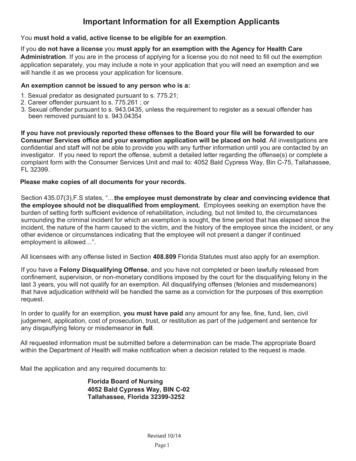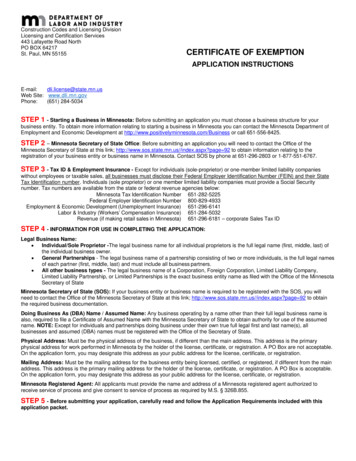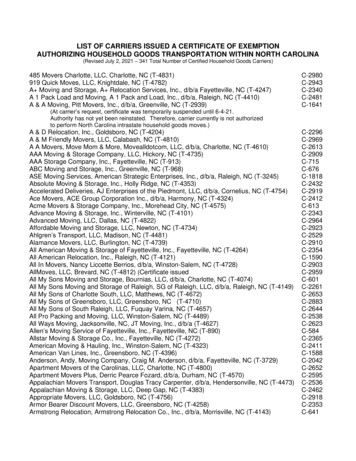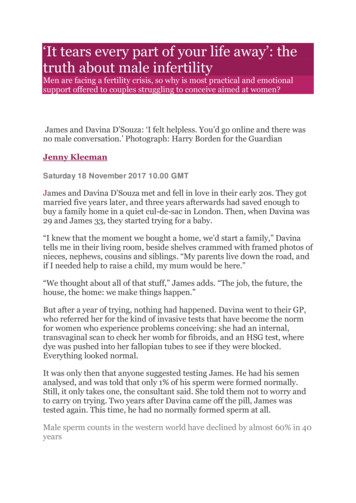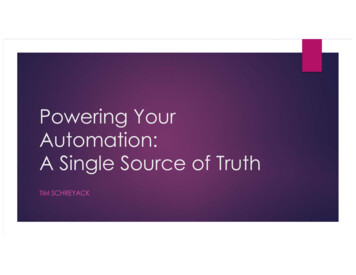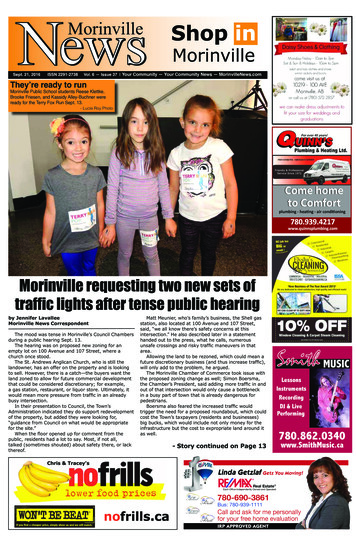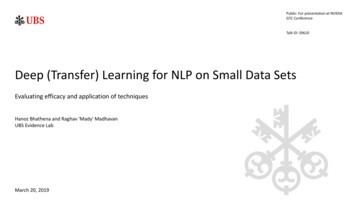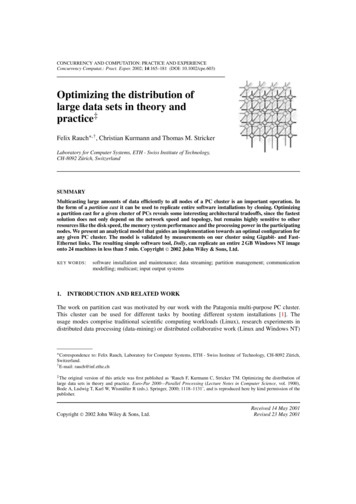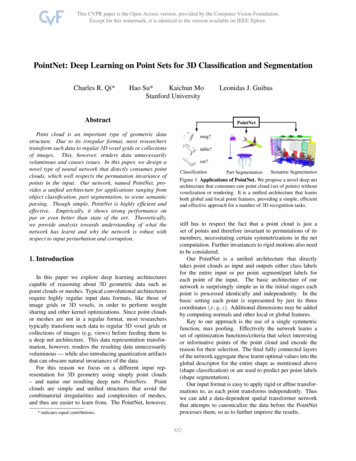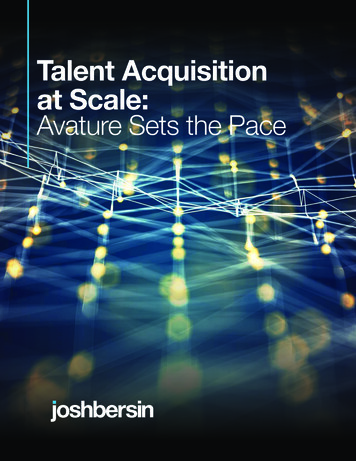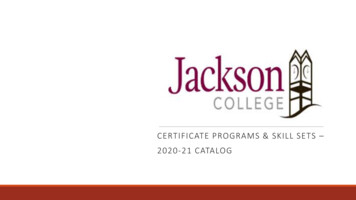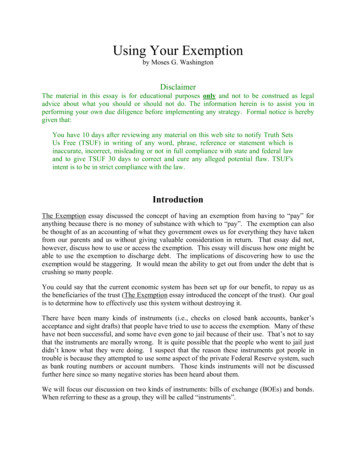
Transcription
Using Your Exemptionby Moses G. WashingtonDisclaimerThe material in this essay is for educational purposes only and not to be construed as legaladvice about what you should or should not do. The information herein is to assist you inperforming your own due diligence before implementing any strategy. Formal notice is herebygiven that:You have 10 days after reviewing any material on this web site to notify Truth SetsUs Free (TSUF) in writing of any word, phrase, reference or statement which isinaccurate, incorrect, misleading or not in full compliance with state and federal lawand to give TSUF 30 days to correct and cure any alleged potential flaw. TSUF'sintent is to be in strict compliance with the law.IntroductionThe Exemption essay discussed the concept of having an exemption from having to “pay” foranything because there is no money of substance with which to “pay”. The exemption can alsobe thought of as an accounting of what they government owes us for everything they have takenfrom our parents and us without giving valuable consideration in return. That essay did not,however, discuss how to use or access the exemption. This essay will discuss how one might beable to use the exemption to discharge debt. The implications of discovering how to use theexemption would be staggering. It would mean the ability to get out from under the debt that iscrushing so many people.You could say that the current economic system has been set up for our benefit, to repay us asthe beneficiaries of the trust (The Exemption essay introduced the concept of the trust). Our goalis to determine how to effectively use this system without destroying it.There have been many kinds of instruments (i.e., checks on closed bank accounts, banker’sacceptance and sight drafts) that people have tried to use to access the exemption. Many of thesehave not been successful, and some have even gone to jail because of their use. That’s not to saythat the instruments are morally wrong. It is quite possible that the people who went to jail justdidn’t know what they were doing. I suspect that the reason these instruments got people introuble is because they attempted to use some aspect of the private Federal Reserve system, suchas bank routing numbers or account numbers. Those kinds instruments will not be discussedfurther here since so many negative stories has been heard about them.We will focus our discussion on two kinds of instruments: bills of exchange (BOEs) and bonds.When referring to these as a group, they will be called “instruments”.
There Is No MoneyBefore we get into the main topic, I want to say a bit about money. I take the position that thereis no “money” or at least no money of substance in our current economic system. You maydisagree with this position and there is certainly room for debate. But, for the sake of clarity, Iwill elaborate why I feel my position is has some merit.One definition of money is a “medium of exchange”. If you want to use this definition, then Iwould have to say that there is money in our economic system. We certainly do exchangemoney or Federal Reserve Notes (FRNs) to get the goods and services that we need. But thisdefinition begins to reveal the problem with what we call “money”.The word “exchange’ means a situation in which equal value is given between two parties. Ifthere is money of substance, then an exchange can take place. By “money of substance”, I meansomething that has intrinsic value of its own, such as gold and silver.Let me illustrate this concept of an exchange. Let’s say it is 1900 and you own a clothing store.You are selling men’s suits for 20. If someone were to give you a 20 gold piece for a suit, anexchange would have taken place. Both the suit and gold have intrinsic value so both partiesreceived equal value.Now, let’s update the story to modern times. You have a clothing store and are selling a suit for 300. Someone comes in and give you 300 in FRNs. A FRN is a note. But w hat is a note?Note. An instrument containing an express and absolute promise of signer (i.e. maker) to pay to aspecified person or order, or bearer, a definite sum of money at a specified time [Black’s Law Dictionary5th Edition]So, a note is a promise to pay at some future date. It is a debt instrument. An FRN is a pledgeon the part of the government to pay a debt. This means that every FRN in circulation is actuallya liability of the federal government. It might appear to be an asset to the one holding it, but itjust means the government will pay off the debt some day when there is substance. FRNs arebacked by the “full faith and credit” of the UNITED STATES. But where is the governmentgoing to get assets to pay off all these liabilities? The government is an artificial entity that hasno source of wealth on it its own. The only source the government has is “We the People”. Thenatural resources of the earth are the source all wealth. But, without people, natural resourceshave no value. Gold, silver, oil, coal, platinum, diamonds, timber, livestock, and crops are allproducts of the earth. None of these have any value until people put their ideas and labor intoconverting the raw materials into something of greater value. So, in one sense, FRNs are only asgood as the willingness of the businesses and people to accept them.Now back to the clothing store illustration. Did the storeowner get anything of intrinsic valuewhen he received the 300 in FRNs? No! The FRN is just paper with no intrusive value. Theowner got a promise for payment at some point in the future by the government. No one candetermine when the promise of payment might be fulfilled. Since the FRN is a debt instrument,the debt for the purchase of the suit was not paid. You can’t pay a debt with a debt; can you? Idon’t think so. All you can do with an FRN is discharge a debt.
While we are talking about money, we also need to discuss the concept of credit. Credit is theability of a person to borrow “money” or obtain goods on time based upon the perception that thedebt will be repaid in the future. All people posses the potential of virtually unlimited creditbecause all people have the potential to pay back a virtually unlimited amount of debt. A man,through his own labor, might be able to make a sizable fortune by panning for or mining gold orany other business venture. In the same way, an inventive man’s ideas might create a vastfortune. Rather than laboring for gold, a man might invent machines and processes that couldmine vast quantities of gold form the earth.If the labor or ideas of people can create a vast amount of wealth, then it could reasonably besaid that people have unlimited amount of credit. This unlimited credit does not apply to justspecial people. It applies to everyone. No one can predict who might be the next person to comeup with a idea, invention, song, book, theory or whatever that might make a huge fortune.This concept of unlimited credit does not hold true for artificial entities, like corporations andgovernments. Artificial entities are not alive and cannot produce one product or idea exceptthrough the efforts of people. If a banker is willing to give a corporation a large amount ofcredit, it is only because the banker is convinced that the corporation has organized their peopleis such a way that they can create the amount of wealth necessary to repay the debt. In fact, onecould say that artificial entities can only create debt. It takes no creative power to create debt. Itdoes, however, take creative power to repay debt.When a company issues a person credit, is the company really risking any of its own resources togive the credit? Research has lead me to the conclusion that the answer is no! A careful study ofModern Money Mechanics, a publication of the Federal Reserve Bank of Chicago, makes it clearthat banks don’t have any money of their own to lend and are forbidden from lending theirdepositors’ “money” when they issue you credit. What they do is exchange (an even swap ofvalue) your promise to pay for credit in an account, FRNs, that you can use to buy goods andservices. Since there was an even exchange, you don’t owe them anything. They got the note,(your promise to pay) as an asset and you got FRNs in an account that you could spend. Sincethey didn’t loan you anything in the first place, the idea of calling them a creditor seemsmisleading. So when we use the term “creditor” in this essay, we will put it in quotes to remindyou that they didn’t loan you anything other than your own credit. We, the living souls, are thereal ultimate creditors because it is only through our labor and ideas that any wealth is created.What we have always called “creditors” in the past are really just fictional organizations(“persons” created by the government) to whom we issue some of our own credit.So, to summarize the points that have been made here, the only kind of “money” in oureconomic system is credit or promises to pay. When you use a credit card, you are using creditwhich is a promise to pay. When you write a check, you are promising that your bank will honorit and transfer credits from your account to the account of the party to whom you wrote thecheck. When you give FRNs for goods and services, you are giving a promise to pay made bythe federal government. So, all we really have is a promise to pay. There is no lawful money ofsubstance in our economy.
SetoffSince all we have is promises to pay, that means you can never actually pay for anything. Theword “pay” implies an exchange of equal value. Since there is no substance backing up ourFRNs, you can’t pay for anything. All you can do is discharge the debt.If it is true that we can’t pay for anything, then how can a BoE or bond discharge a debt? It isdone with setoffs.setoff. 2. A debtor’s right to reduce the amount of a debt by any sum the creditor owes the debtor; thecounterbalancing sum owed by the creditor. Set-off signifies the subtraction or taking away of onedemand from another opposite or cross demand, so as to distinguish the smaller demand and reduce thegreater by the amount of the less [Black’s Law Dictionary, 7th Edition]When we issue one of the instruments we are discussing, bookkeeping entries should be made toreduce the amount of money owed to our “creditor”. Let’s use an example to clarify this“ledgering”. Let’s say that Bill obtained a 100,000 loan from Corey, and Corey got 1,000 loanfrom Adam. The three balance sheets shown below reflect the initial situation.AdamAsset Liability1,0001,000receivable paid Coreyfrom CoreycashBillAsset100,000cash fromCoreyLiability100,000owe CoreyCoreyAsset Liability100,000 100,000receivable paid Billcashfrom Bill1,0001,000cash owe AdamNow, let’s say that Corey wants to discharge his debt to Adam by using a draft. A draft is athree-party instrument where party A (drawer), asks party B (drawee) to pay party C (payee).So, in our example, Corey (drawer) is going to issue a 1,000 draft where Bill (drawee) isinstructed to pay 1,000 to Adam (payee). In essence, the draft would cause setoff transactionsin the balance sheet of Adam, Bill and Corey. No real “money” needs to trade hands toaccomplish the discharge of the debt. The balance sheets below show the result for each ility99,000owe CoreyCoreyAsset Liability99,00099,000receivable paid Billfrom BillcashNow, let’s change the names of the players. Let’s say that Adam is one of your “creditors”, Billis the federal government, and Corey is you. The amount of debt owed by the federalgovernment is very large because of your exemption. The same concept applies with this newscenario. The government and your creditor could do setoff transactions to remove your debt.The actual mechanism would be somewhat more complicated because the creditor’s bank wouldget involved, but the principles and ledgering entries are the same.When we use a BoE or a bond, we are asking the government to discharge our debt for us out ofthe “money” that they owe us (exemption). The payee for these transactions would be the
Secretary of the Treasury, who is also the trustee for the U.S. bankruptcy. As such, he isresponsible for distributing all funds, just like any other trustee in a bankruptcy proceeding. So,we ask him to be our banker and discharge our debts for us. This is what HJR 192 of June 5,1933 says the government will do: The government will discharge our debts “dollar for dollar”.Other than FRNs, most of “money” that flows in our economy is just bookkeeping entries ordigits in various computers. When debts are discharged, no real money flows. The only thingthat happens is that bookkeeping entries are made on various computer systems. When you writea check to a merchant, eventually the merchant’s checking account will be credited with theamount of the check, and your checking account will be debited with the same amount. Whenyou use a debit card, the same thing happens. The only thing that is different is that no check iswritten; it’s all done electronically.Debts That Can Be DischargedNow we’ll describe what kinds of debts can be discharged with these instruments. BoEs andbonds can only be used to discharge public debts - not private debts. But what is public debt andwhat is a private debt? I define private debt as debt between two living souls (man to man, manto woman, etc) and public as debt to any legal fiction or any entity created by or authorized bythe government. This means the “public” would include any government entity (municipalcorporation), any corporation (S Corp or C Corp), limited liability company or partnership,statutory trust, partnerships or DBA (doing business as). All “public” entities have madeapplication and received permission to exist.In order to discharge a public debt, there would have to be a charging instrument or a billitemizing the debt. The charging instrument would show how much was owed and to whom itwas owed. The charging instrument
If it is true that we can’t pay for anything, then how can a BoE or bond discharge a debt? It is done with setoffs. setoff. 2. A debtor’s right to reduce the amount of a debt by any sum the creditor owes the debtor; the counterbalancing sum owed by the creditor.
